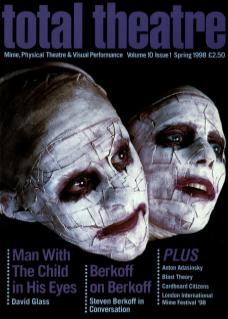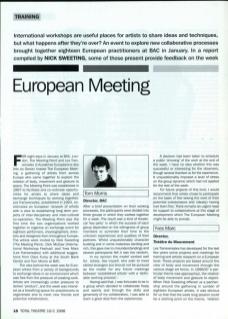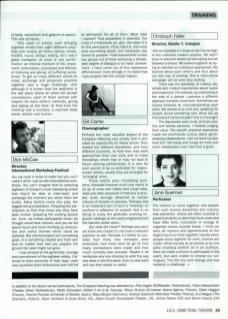For eight days in January at BAC, London, The Meeting Point and Les Tranversales (L'Académie Européenne des Arts du Geste) hosted The European Meeting, a gathering of artists from across Europe who came together to explore the relation of body, movement and gesture to space. The Meeting Point was established in 1997 to facilitate and coordinate opportunities for artists to share ideas and exchange techniques by working together. Les Transversales, established in 1993, coordinates a European network of artists with a view to establishing long term projects of interdisciplinary and intercultural cooperation. The Meeting Point was the first time the two organisations worked together to organise an exchange event for eighteen performers, choreographers, directors and designers from throughout Europe. The artists were invited by Nick Sweeting (The Meeting Point), Dick McCaw (International Workshop Festival) and Yves Marc (Les Transversales) with additional suggestions from Clare Furey at the South Bank Centre and Tom Morris at BAC.
The idea behind the week was for European artists from a variety of backgrounds to exchange ideas in an environment which was free from the pressure of creating work. Artists are increasingly under pressure to deliver 'product', and the week was intended as a breathing space for practitioners to regenerate and to meet new friends and potential collaborators.
Tom Morris – Director, BAC
After a brief presentation on their working processes, the participants were divided into three groups in which they worked together for a week. The result was a kind of theatrical key party in which the success of each group depended on the willingness of group members to surrender their time to the unknown experiences and qualities of their partners. Whilst unquestionably character-building and in some instances exciting and rich, this gave rise to misunderstandings and several participants felt it was too random.
In my opinion the model worked well for artists, like myself, who wish to meet skilled strangers but should not be pursued as the model for any future meetings between ‘established artists' with a 'definable working process'.
Having said that, I was fortunate to be in a group which decided to collaborate freely and openly, and through the skills and generosity of my collaborators I was able to learn a great deal from the experiences.
A decision had been taken to schedule a public 'showing’ of the work at the end of the week. I have no idea whether this was successful or interesting for the observers, though several thanked us for the experience. It unquestionably imposed a level of stress on the group dynamic which had not applied for the rest of the week.
For future projects of this kind, I would recommend that artists chose to participate on the basis of first seeing the work of their potential collaborators and (ideally) having met them first. There remains an urgent need for support to collaborations at this stage of development which The European Meeting might be able to provide.
Yves Marc – Director, Théâtre du Mouvement
Les Transversales has developed for the last few years some projects and meetings for training and artistic research on a European level. These projects are based around the view of body and movement through the various stage art forms. In 1996/97 a particular theme was approached, the relation of body movement and gesture to object. When Nick Sweeting offered us a partnership around the gathering in London of eighteen European artists, it was obvious for us that that the week-long session could be a starting point on the theme, ‘relation of body, movement and gesture to space’. This was achieved.
This week of artistic work bringing together artists from eight different countries and various art forms (dance, mime, theatre, music, design, writing, etc) was a great metaphor of what is live performance: an intense moment of life, enjoyment, enthusiasm, successes and failures, of listening and giving, of suffering sometimes. To get so many different artists to meet, exchange and physically practice together was a huge challenge. And although it is known that the aesthetic is the last place where an artist will accept concessions, each of them worked with respect for each other's methods, giving and taking all the time. At that level the meeting was a success; it reached deep areas, artistic and human.
Dick McCaw – Director, International Workshop Festival
You can lead a horse to water but you can't make it drink. Just so with international workshops. You can't imagine that by selecting eighteen of Europe's most interesting artists that they'll be able to inter-react and exchange the moment you show them the studio. Many factors come into play, the biggest being preparation. Preparing the participants so that they know why they have been invited, preparing the working spaces, etc. Sure, we invited participants whom we thought would best interact, and yes we did spend hours and hours thinking up provocative and useful themes which could be explored. But communication isn't something given. It is something created and hard won and no matter how well you prepare the ground the seed might not grow.
I was amazed at the generosity, courage and commitment of the eighteen artists. I listened to their accounts of their days' work over countless pints of Guinness and I left full of admiration for all of them. What have I learned? That preparation is essential. The more of a framework you give, the easier it is for the participants. If they reject it, and move onto something better, the framework has served its purpose. I have learned that to have two groups out of three achieving a remarkable degree of dialogue is no mean achievement. I have come out of this experience affirmed even more strongly in my belief that more projects like this should happen.
Gill Clarke – Choreographer
Perhaps the most valuable aspect of the European Meeting was simply that it provided an opportunity for fellow artists, from related but different disciplines, and from different countries, to hear how they each approached their own work and to make friendships which may or may not lead to future working partnerships. It is rare for such events to be coordinated for 'experienced' artists, usually they are arranged for 'emerging' ones.
These events pose interesting problems, because however much one wants to let go of one’s own habits and usual roles, what one often discovers is that one is actually quite strongly attached to certain notions of theatre or process. Perhaps this is an important part of such a 'meeting': to confront a reflection of oneself. And in so doing to enjoy the gradually evolving linguistic mélange as the week progressed and the barriers broke down.
But what did I learn? Perhaps one can't yet know and maybe it's not even a relevant question to ask. Perhaps it's better to consider how many new concepts were embraced, how many were let go of, how many connections were made and how much curiosity was aroused. Maybe it all reinforces why one chooses to work the way one does in the first place. Even to step back and see that clearly is useful.
Christoph Falke – Director, Studio 7, Cologne
I felt we repeated in miniature the natural logic of any collective creative process. We didn't know in advance where we were going but we followed a thread. We worked together by trying to maintain our individual approaches. We learned about each other's and thus about our own way of working. This is intercultural exchange; yet we were also working.
There was the possibility of making very simple and modest experiences about space and movement. For example, by improvising at the side of a dancer to perceive a different approach towards movement. Sometimes we moved forwards by misunderstanding each other. We arrived at an end and, speaking for myself, found something new. What did we find and is it communicable? And is it enough?
The discoveries were small, at times even tiny and strictly personal. I hesitate judging their value. The specific practical experience made me enormously curious about genre-crossing collaborations. I did not leave London tired but I left thirsty and hungry for more and more collaboration and I feel that is good.
Jane Guernier – Performer
The chance to come together with people from such diverse disciplines and cultures was wonderful. Artists are often involved in present projects or planning future ones and have little time, inclination or energy to organise events outside these. I think we were all nervous and apprehensive at the beginning of our time together. Usually when people come together for work, choices are made; either equally by all parties or by one party choosing another as in an audition. Here we made a choice to participate in the event, but were unable to choose our colleagues. This felt new and strange and was certainly a challenge.
In addition to the above named participants, The European Meeting was attended by: Frits Vogels (Griftheater, Netherlands), Frans Maleschaert (Theater Sirkel, Netherlands), Mette Edvardsen (Ballet C de la B, Norway), Kitsou Dubois (European Space Agency, France), Claire Heggen (France), Vicente Fuentes (University of Madrid, Spain), Maya Brosch (Germany), Andrzej Sadowski (Mandala Theater, Poland), Eva Magyar (The Shamans, Poland), Alison Andrews (A Quiet Word, UK), Julian Crouch (Improbable Theatre, UFO), James Keane (UK), and Simon Vincenzi (UK)


